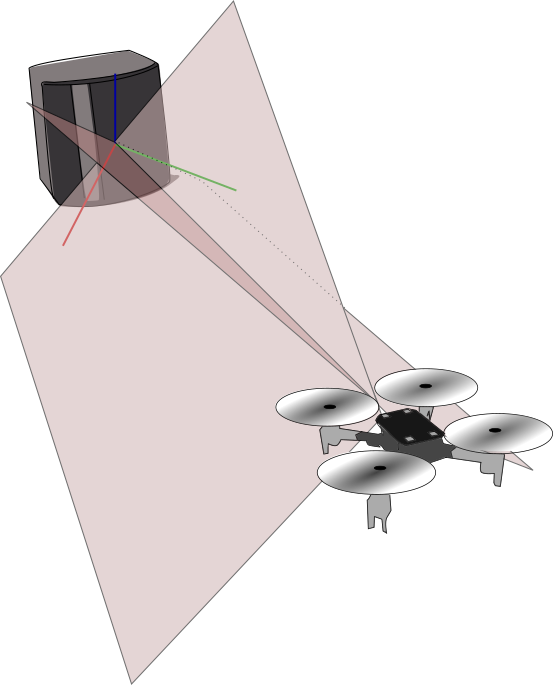We’re happy to announce that we have taken an important step forward in the development of the lighthouse positioning system, we have improved the calibration compensation. The changes improves the correctness of the coordinate system, especially for lighthouse V2 base stations.

As mentioned in this blog post one of the remaining areas to solve was handling of calibration data and this is what we have addressed lately. In the manufacturing process mechanical elements are mounted within some tolerances but since the precision of the system is so good, also a very fine tolerances makes a big difference in the end result. Each base station is measured in the factory and the calibration data describing these imperfections are stored in the base station. The calibration data is transmitted in the light sweeps to enable a receiver to use it to correct for the errors in the measured angles.
As with everything else related to lighthouse, there is no official information of how to interpret the calibration data so we (and the community) had to make educated guesses.
Lighthouse 1
The compensation model for lighthouse 1 has been known for quite long, see the Astrobee project by Nasa and Libsurvive. The most important parameter is the phase and until now this is the only part of the calib data that we have used in the firmware. In the new implementation we use all parameters.
The parameters of the lighthouse 1 calibration model are phase, tilt, gib mag, gib phase and curve.
Lighthouse 2
The compensation data for lighthouse 2 is similar to lighthouse 1 but there are two new parameters, ogee mag and ogee phase. It also seems as some parameters that are sharing names between lighthouse 1 and 2 have different meanings, for instance curve.
Libsurvive has implemented compensation for lighthouse 2 but we have unfortunately not managed to use their work with good results, instead we have tried to figure out what the model might look like and match it to measurements. We have managed to get good results for the phase, tilt, gib mag and gib phase, while we don’t know how to use curve and ogee mag and ogee phase. The solution seems to be pretty good with a subset of the parameters and we have decided to leave it at that for now.
Use of calibration data
The way we have used the calibration data so far has been to apply it to the measured angles to get (more) correct sweep angles that have been fed into the position estimation algorithms. The problem is that the compensation model is designed the other way around, i.e. it goes from correct angles to measured angles, and an iterative approach is required to apply it to the measured angles. A better way (most likely by design) is to apply it in the kalman estimator instead where it simply becomes part of the measurement model.
Currently we do calculate the corrected angles as well and expose them as log data, but it is not required for the standard functionality of the lighthouse system. We may make it possible to turn it on/off via a parameter in the future to save some CPU power.
Functional improvements
So what kind of improvements will the calibration add?
The first improvement is the base station geometry estimation. With more correct angles the estimated base station position and orientation will be better. This is important to be able to get a good estimation of the Crazyflie position since poor geometry data will give the position estimator conflicting data.
Secondly more correct angles will straighten the coordinate system. With angular distortion the position estimator will not be able to estimate the correct position and the coordinate system will be warped, bent or stretched. The improvement can be seen when flying parallel to the floor at constant height for instance.
Thirdly the stability will hopefully be improved. When the angles from two base stations match better, the estimated position will change less when one base station is occluded and generally make life easier for the position estimator. We will take a look at the outlier filter to see if it can be improved as well.
Remaining problems
The calibration data is transmitted as a part of the sweeping light planes with a low bitrate. For lighthouse 1 the decoding process works well and all calibration data is usually received within 20-30 seconds. For lighthouse 2 it does not work as well in our current implementation it takes (much) longer before all data has been received correctly from both base stations.
It is possible to get the calibration data via the USB port on lighthouse 2 and we are considering storing the calibration data in the Crazyflie somehow instead. This will be even more important when we support larger systems (2+ base stations) and all base stations are not within range at startup.
Hi sir,
The calibration of LH2 is so mysterious, I have only guessed tilt ( mesurement_angle = ideal_angle + tilt) .
How do you use phase, tilt, gib mag and gib phase ?
Hi!
I agree and we don’t understand all of it yet. You can find our implementation on github https://github.com/bitcraze/crazyflie-firmware/blob/2021.03/src/utils/src/lighthouse/lighthouse_calibration.c#L140-L150 with some general docs in https://www.bitcraze.io/documentation/repository/crazyflie-firmware/master/functional-areas/lighthouse/.
As you can see we currently use phase, tilt and gib but have not been able to figure out curve and ogee.